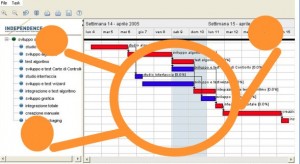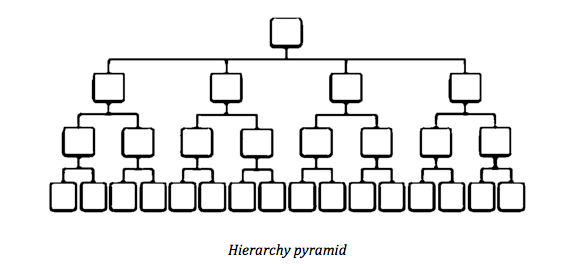 Is there an organizational design that can replace the artificial barriers and fear of the traditional hierarchy? Digital cowboys, the new generation of talent described in Pekka Viljakainen’s book ‘No Fear’ , reject the form and values of the traditional organization. We continue our series in response to Pekka’s invitation to outline how we at Intelligent Management would tackle driving out fear in the post-digital age.
Is there an organizational design that can replace the artificial barriers and fear of the traditional hierarchy? Digital cowboys, the new generation of talent described in Pekka Viljakainen’s book ‘No Fear’ , reject the form and values of the traditional organization. We continue our series in response to Pekka’s invitation to outline how we at Intelligent Management would tackle driving out fear in the post-digital age.
Traditionally, when we translate the hierarchy into a company structure it resembles the well-known pyramid below. While this shape is perfect for those concerned with power games and personal success, it does not satisfy the network and collaboration-based values of Digital Cowboys, nor does it optimize achieving the goal of the organization. Why is that?
The vertical lines that connect the boxes clearly define the span of control and the accountability of those boxes. Along with the accountability goes the amount of individual power that those boxes have. A hierarchy is then conventionally translated into a mechanism of control and reporting. Accordingly, we can easily conclude that the pyramid cannot achieve the goal of creating the orderly coherence among the individual efforts that we were seeking due to the separations it imposes.
Is there another way to create that coherence, hence giving the hierarchy its natural role of creating order? There is, but we do need to make a cognitive effort to grasp it. One step at a time.
Building the interdependencies
At its most basic level, if you can imagine an x-ray of a company, any company can be seen as a set of recurring and non-recurring activities. For instance, ordinary maintenance, book closing, production scheduling, shipping, etc. are recurring activities; the introduction of a new technology, the expansion of premises, and the launch of a new product can be seen, in a way, as non-recurring activities. If we view a company as a system then we must understand how to build the interdependencies that make up this set of activities and how these interdependencies evolve in time.
This is an important point: not only do we need to know how these activities are going to take place (this can be done by mapping processes with a deployed flowchart) but also the timing of this evolution and we need a method to control it. As a deployment flowchart clearly shows (see below), virtually any activity that an organization undertakes is cross-functional; this realization alone should be enough to dismantle the idea of the validity of a functional organization. Moreover, these interdependencies must be staffed and managed within a temporal spread.

The new organization: the network of projects
So, to recap, we know that the hierarchical/functional model is inadequate as it creates artificial barriers and does not allow a true understanding of the organization as a series of recurring and non-recurring activities. An organizational structure should therefore be designed to facilitate the orderly management of sets of activities that are continuously created, coordinated, cross-functional, and that evolve in time. There is a precise name for this in English: a project.
A project is exactly this: a network of interdependencies created to achieve a precise goal in a well-defined time frame . A project is a system with a precise duration. A company viewed as a system is therefore a network of projects, and the orderly creation and timely completion of these projects should accomplish the stated goal of the network.
What are we saying here?
1) A functional structure is not suitable to support the systemic approach to managing organizations, and organizations by the nature of their work are cooperative and cross-functional. This is because none of the activities of any company can be performed within the narrow boundaries of a single function;
2) Any plausible template for an organizational structure that can foster cooperative work must also take into account the evolution in time of the interdependencies needed to accomplish any activity;
3) In essence, the management of any organization becomes the management of a network of recurring, orderly and evolving-in-time activities. We call them projects. The appropriate hierarchy is exercised through ensuring orderly coordination, not functional reporting;
4) The backbone of any organizational effort becomes, then, the ability to manage the network of projects any organization is made up of;
5) We can safely say that the springboard to overcome the seemingly untouchable functional structure is the idea of a company seen as a network (with a stated goal) of projects.
In our next post, we look at career paths in the Network of Projects organization.
See also:
Can We Do Away with Hierarchy?
No Fear in the Workplace – Making It Happen
Drive Out Fear by Learning to Think Systemically
Don’t Climb, Grow! Success in the Systemic Organization
Start Making Sense: Introduction To Statistical Process Control
Sechel: Logic, Language and Tools to Manage Any Organization as a Network of Projects






Leave a Reply